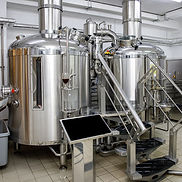Protecting Your Stainless, Part I
The explosion of new craft breweries in the United States in recent years coupled with imported stainless steel of inferior quality, has created a much greater need to make sure new brewing equipment is properly passivated prior to being put into use. What does passivation mean? How does one passivate brewing equipment? This article will detail the chemicals and procedures brewers should use to passivate brewing
equipment and ensure their beers will taste like they should – fresh, flavorful and free of metallic or any other off-flavors.
What Is Passivation?
Passivation in brewing is defined as the process of chemically treating stainless steel with an invisible, protective layer or coating so the metal will not be as susceptible to corrosion and pitting caused by cleaning chemicals (acids, caustics, sanitizers), carbon dioxide (CO2) and beer. Stainless steel by definition is a very hard and durable metal, but it is not as indestructible as most people may think. Certain chemicals, especially
chlorides (e.g. table salt, NaCl), are known to be very hard on stainless steel and can cause pitting if the metal is not passivated to avoid corrosion. Even beer, with its lower pH and CO2, can cause pitting to stainless steel over time.
What Is Descaling and Pickling?
Although often confused with passivation, pickling and descaling (oxide removal) must first be performed to clean down to bare metal for the subsequent passivation steps to be successful. Although used synonymously with passivation, descaling and pickling remove the oxides from the metal to enable effective passivation. Pickling of metal is done to remove iron and oxides from stainless steel. If the metal is not cleaned first, it
will not be passivated. Descaling and pickling are done with very strong acids including hydrochloric acid (HCl), nitric acid (HNO3), hydrofluoric acid (HF) or sulfuric acid (H2SO4).
Traditional Passivation
The two most common chemicals traditionally used for stainless steel passivation for breweries are citric acid and nitric acid. Citric acid is a mild, organic acid and is very good at chelating iron, but does not by itself leave behind a protective coating to keep the metal from being passive (impervious to chemical attack). Nitric acid used in high concentration (about 20% active or more) is the most well-known method of passivation
and, when followed by a 24-hour air dry, creates an invisible chromium oxide (Cr203) layer to protect the metal.
A problem with this method is that it is not permanent and is rarely (if ever) repeated in the brewery due to the hazards of using an extremely dangerous concentration of nitric acid. This presents a problem for brewers who do not regularly deep clean and repassivate the metal on a regular basis – at least twice a year. So, what is a brewer to do to safely keep the metal not only clean, but in pristine, like-new condition?
Newer, Safer Passivation
There are ways to keep the metal in good condition, flavor-neutral and shiny without having to resort to extremely hazardous chemicals and concentrations. Acid cleaning and drying to form the Cr203 layer no longer work as well as they once did and create a condition called “flash rusting” (iron deposit) especially around welds. Using a nitric acid blend immediately followed by alkaline noncaustic cleaner method, first detailed in The New Brewer (Noncaustic Cleaning In The Brewery, March/April, 1996), is still widely used and is one of the best ways to not only keep the metal clean, but passivated at the same time. Many breweries that adopted this cleaning regime over 20 years ago still use it, regardless of whether they’ve outgrown their original equipment or not.
Conversion Coating Passivation
Following the acid with noncaustic alkaline cleaner may seem at first to be completely foreign to brewers who consistently use the caustic-rinse, acid-rinse method of cleaning their tanks. While the tried-and-true method works well to remove protein soil, it tends to be less effective on beerstone and does not properly passivate the metal. Over time, soils can build up, and the metal can develop microbial induced corrosion (MIC). If left unchecked, these deposits can pit the metal. So, how should you treat metal to keep it in excellent condition?
Here is the procedure for existing equipment (brewhouse and fermentation vessels):
1. Rinse excess soil if necessary.
2. Put in 1-2 ounces per gallon of water of nitric/phosphoric acid blend. Make sure pH is 2 or lower. Recirculate through sprayballs for a minimum of 15 minutes at a maximum temperature of 140° F. [Do not exceed 140° F (60° C)] to keep the nitric acid in the solution, not in the air.
3. Drain the acid solution but do not rinse!
4. Depending on soil conditions, put in 1-2 ounces per gallon of non-caustic alkaline cleaner that contains either hydrogen peroxide or sodium per carbonate. Recirculate through sprayballs and/or heat exchanger at 120-140° F (50-60° C) for 15-30 minutes.
5. Drain solution. Immediately follow with step 6.
6. Rinse equipment, preferably with the same temperature of hot potable water. Check the pH of rinse water and vessel wall if possible. When pH is neutral, the passivation step is complete.
As appeared in The New Brewer, July/August 2018, published by the BA.
Continue to learn about passivation for new equipment in Protecting Your Stainless Steel: Passivation for Brewery Equipment, Part 2.
Contributing Author
Dana Johnson Founder/Co-Owner, Ska Fabricating
A homebrewer since 1989, Dana consults for craft breweries, wineries & distilleries on food safety & sanitation practices. He has more than 25 years of experience serving Birko’s brewery customers and is known in the industry as one of the leading voices on sanitation. He has formulated many Birko products, has authored numerous articles, is a frequent speaker, and leads many industry support committees.
Don't Laugh at My Fermenter
Tom Hennessy
We have had hundreds of students go through our immersion course that have resulted in at least 130 breweries around the world. 99% of the students have become good friends too. If you are ever at a brewery though and you see a Letina Tank used as a fermentation vessel, you can be pretty sure the owner may be an alum.
A little background: When I needed to replace the beast fermenters at Colorado Boy in Ridgway, I didn’t have much room to work with. The brewhouse including fermentation is only 10x15. I kept looking at these
How to Remove Silicon Dioxide (SiO2)
Fining Agents in Fermentation Vessels and Brite Tanks in the Brewery
Dana Johnson
Brewers have been using silicon dioxide (SiO2)-containing products, also known as silicic acid, silica, or kieselsol, to remove yeast and haze-forming particles from beer in the fermenter or brite tank for many years now. The use of silicon dioxide allows brewers to achieve a relatively “brite” (clear) beer without the need of filtration, which can remove not only proteins but also many positive flavor components from the beer. The mechanism of how silica-containing auxiliary fining products work has been discussed in great detail over the years, but the removal of residual silica has not. The cleaning process for silica is not
Protecting Your Stainless, Part II
Dana Johnson
This is a continuation of Protecting Your Stainless Steel: Passivation for Brewery Equipment, Part 1, which defines and discusses passivation in an existing brewhouse.
What about new equipment?
Assuming the metal has already been passivated at the factory, new stainless steel should be in fairly decent shape when it arrives at your brewery. There can however be residual machine oil, road grime, dust, dirt and debris on new metal. In this case, an alkaline hot caustic cleaning is recommended to remove
ACT
-
Estimate desired production
-
Research available utilities
-
Evaluate space constraints
-
Forecast scaling up production
-
Research equipment options
-
Select equipment/financing
-
Purchase/order equipment
-
Install equipment
-
Brew/package test batches
oPEN
-
Dial in equipment efficiencies
-
Establish sanitation SOP
-
Establish maintenance SOP
-
Consult vendor with issues
GrOW
-
Consider equipment upgrades
-
Research additional tank capacity
-
Evaluate silo or bulk packaging needs










